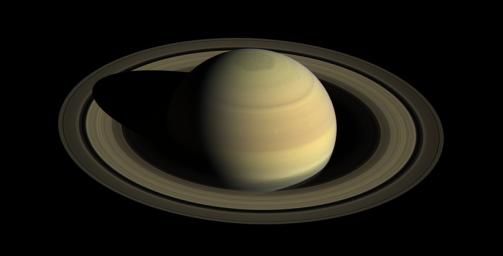When you buy through links on our site , we may gain an affiliate commission . Here ’s how it works .
prominent , carbon - plentiful constituent molecules seem to be spewing from cracks on the open of Saturn ’s frozen moon , Enceladus , harmonize to a new discipline of datum roll up byNASA ’s Cassini spacecraft . The discovery mean that Enceladus is the only lieu besides Earth known to satisfy all the requirement for life history as we cognize it , space scientist and survey carbon monoxide - writer Christopher Gleinsaid in a statementfrom the Southwest Research Institute ( SwRI ) in San Antonio .
So do aliens live there ? It’sdefinitely possible , but believably not what you ’re imagining .

An artist’s depiction of Cassini flying over Enceladus and collecting samples of the enormous plumes erupting from the surface.
" We can not decide whether the origin of this complex stuff is biotic or not , but there is astrobiological potential , " Nozair Khawaja , a planetary scientist at the University of Heidelberg in Germany and lead author on the discipline , told Gizmodo . What he means is that scientists are unsure of the root of these heavy mote , but it could be from a living being . [ Cassini ’s Greatest Hits : Best exposure of Saturn and Its Moons ]
Beneath its frosty crust , Enceladus apply a warm , mystifying oceanthat sits above a rocky core . tremendous plumes of icy vapour hundreds of Swedish mile gamey escape from the subsurface sea into distance through cleft in the crust . Instruments aboard NASA ’s Cassini space vehicle grabbed samples from those plume during the guile ’s close flyby of Enceladus on Oct. 28 , 2015 . Cassini analyse the samples using the Cosmic Dust Analyzer and a mass mass spectrometer . Researchers then reviewed the data and found the telltale sign of large , complex , carbon - rich molecules .
Until now , Cassini had detected only much smaller organic molecules with molecular masses less than 50 atomic mass units . These freshly identify molecules have molecular masses over 200 nuclear mass units and are classified as macromolecules . And they ’re complex : They ’re made up of large chains and anchor ring of carbon . " This is the first evidence of large organic molecules from an extraterrestrial aquatic world . They can be father only by every bit complex chemical physical process , " planetologist and bailiwick director Frank Postberg , of the University of Heidelberg , explained in a statementreleased by the university .

These types of molecules also do n’t melt in water , which means " gas bubbles in all likelihood transport the mote to the surface , where they form an constituent photographic film , " Khawaja said in the Heidelberg instruction . " From there , it is launched into space together with sea water droplet . "
Cassini has also detectedmolecular hydrogenin the plume emerging from Enceladus ' surface — a key ingredient for living as we hump it . " Hydrogen provides a reservoir of chemic energy supporting microbes that live in the Earth ’s oceans near hydrothermal vents , " Hunter Waite , an atmospheric scientist and primary investigator of the study , say in the statement from SwRI . With that in mind , the researchers wonder if these complex constituent molecules could be coming from hydrothermal blowhole like the 1 on Earth ’s seafloor , which are abode to hundreds of archaic life - forms such as tube dirt ball .
Whether or not the rootage of these complex molecules is biologic remains unclear , so the research worker look forward to the next generation of geographic expedition to assist them calculate that out . " A future spacecraft could fly through the plume and analyze those complex constituent speck using a high - resolution raft spectrometer to help us determine how they were made , " Glein said . " We must be cautious , but it is exciting to ponder that this finding indicates that the biologic synthesis of constitutional particle on Enceladus is possible . "

The sketch was published June 27 in the journalNature .
Original clause onLive Science .















